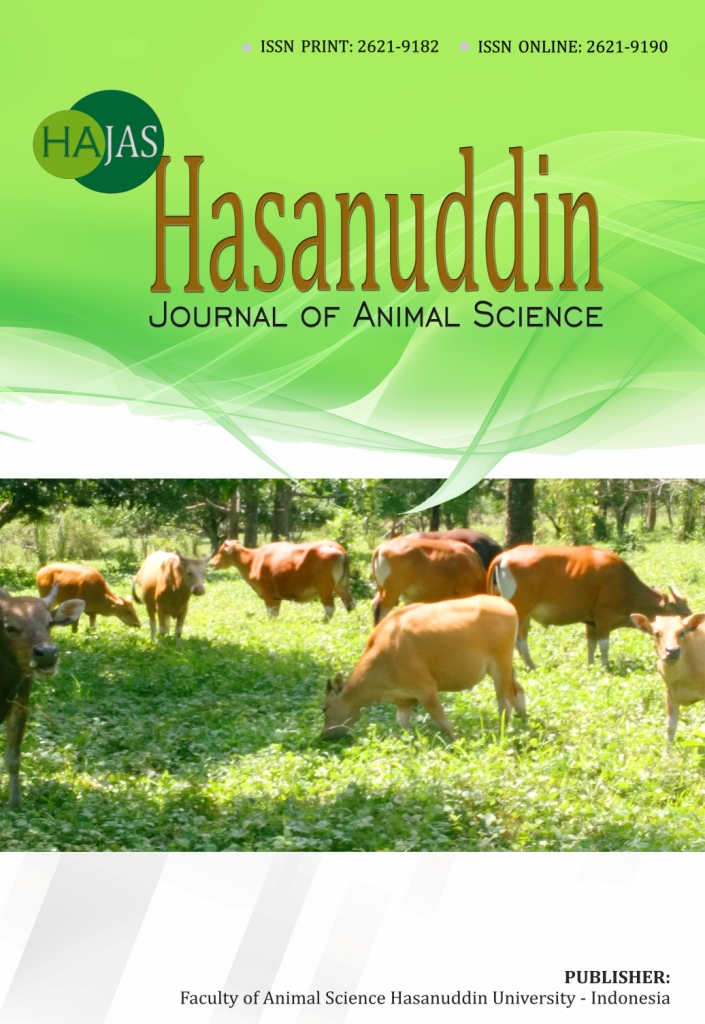Farmer Participation in Maiwa Breeding Center Program In Barru Regency, South Sulawesi
DOI:
https://doi.org/10.20956/hajas.v1i1.6596Keywords:
Key words, Participation, Bali Cattle, Breeding, MBC, BarruAbstract
Abstrak The Maiwa Breeding Center program was a communiversity program from Hasanuddin University in the form of a Bali cattle nursery. The aim of this program was to preserve Bali cattle germplasm and improve the genetic quality of Bali cattle while increasing farmer income. The participation of farmers in implementing the MBC program was the key to the success of the program. The purpose of this study was to determine the level of farmer participation in the MBC program in Barru District. The number of respondents was 72 people who were randomly selected from 234 MBC partner farmers. Data was collected by enumerators who have been trained using questionnaires. The measured variable was the level of farmer participation during program planning, program implementation, program monitoring and evaluation and utilization of the results of the nursery program. Variables were measured using scores 1 - 4, namely from not participating, low participation, high participation and very high participation. Data analysis uses frequency distribution and continuum value table. The results showed that the participation of farmers in planning and monitoring and evaluation was in the low category. The participation of farmers in the implementation and utilization of results was in the high category. Overall, farmer participation in Bali cattle breeding activities was in the high category.Downloads
References
References
Ali, T., M. Ahmad, B. Shahbaz and A. Suleri. Impact of Paricipatory Forest Management on Vulnerability and Livelihood Assets of Forest-Dependent Communities in Northern Pakistan. Int. J Sust. Dev. World 14:211-223.
Amalo, S., B. Hartono, H.D. Utami. 2012. Model simulasi peningkatan ternak sapi induk pola gaduhan terhadap curahan tenaga kerja: Studi kasus di Kecamatan Amanuban Selatan Provinsi Nusa Tenggara Timur. Sains Peternakan Vol. 10(1):30-38.
Anggraeni, L. 2009. Factors Influencing Participation and Credit Constraints of a Financial Self-Help Group in Remote Rural Area: The Case of ROSCA And ASCRA in Kemang Village West Java. Journal of Applied Sciences 1:1-11.
Badan Pusat Statistik. 2017. Statistik Peternakan Indonesia. Badan Pusat Statistik Nasional, Jakarta.
Cardoso, S.P. and H.S. James Jr. 2010. Ethical Framework and Farmer Participation in Controversial Farming Practices. J. Agric. Environ. Ethics DOI10.1007/s10806-011-9306-6.
Dinas Pertanian Kabupaten Barru. 2015. Petunjuk Teknis pembibitan sapi di Bali. Dinas Pertanian Kabupaten Barru, Barru.
Duraippah, A.K., P. Roddy and J.E. Parry. 2005. Have Participatory Approaches Increased Capabilities? International Institute for Sustainable Development. Winnipeg, Mannitoba.
Goff, S., J.R. Lindner, and D. Dolly. 2008. Factors in Participation and Non-Participation in Farmer Field Schools in Trinidad and Tobago. Proceedings of the 24th Annual Meeting AIAEE, EARTH University, Costarica. P. 214-224.
Ife, J. dan F. Tesoriero. 2008. Community Development: Alternatif Pengembangan Masyarakat di Era Globalisasi. Terjemahan: S. Manullang, N. Yakin, M. Nursahid. Pustaka Pelajar, Yogyakarta.
Mardikanto, T. 2009. Sistem Penyuluhan di Indonesia. UNS Press, Solo.
Ngoc Chi, T.T., P.V. Liem, T. Pharis. 2007. Farmers Participation in Rice Variety Selection. Journal of Omonrice 15: 159-163.
Telupere, F.M.S., dan N.G.F. Katipana. 2014. Pengaruh ketinggi tempat dan sistem pemeliharaan terhadap korelasi genetic bobot lahir dan bobot dewasa Sapi Bali. Jurnal Nukleus Peternakan, Vol. 1 No.1 14-20.










